

Six ways Australia's education system is failing our kids. Amid debates about budget cuts and the rising costs of schools and degrees, there is one debate receiving alarmingly little attention in Australia.
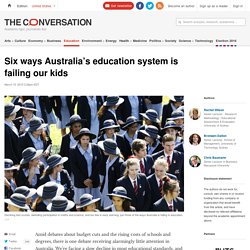
We’re facing a slow decline in most educational standards, and few are aware just how bad the situation is getting. These are just six of the ways that Australia’s education system is seriously failing our kids. 1. Australian teens are falling behind, as others race ahead The Programme for International Student Assessment (PISA) survey tests the skills and knowledge of 15-year-old students in more than 70 economies worldwide. Although there has been much media attention on falling international ranks, it is actually this decline in real scores that should hit the headlines. Australian education system. Why poor kids continue to do poorly in the education game. The Conversation is running a series, Class in Australia, to identify, illuminate and debate its many manifestations.
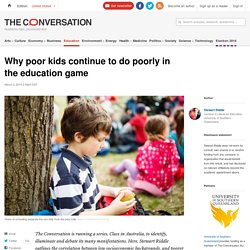
Here, Stewart Riddle outlines the correlation between low socioeconomic backgrounds, and poorer results in the classroom. We like to pretend that social class doesn’t matter in Australia, but the reality for children from low socioeconomic backgrounds paints a very different picture when it comes to education. Expanding career options for women - Scholarship Program. Page Content The State Government is encouraging women to take up non-traditional industries and trades and occupations where women currently make up less than 25 per cent of the total workforce.

Up to 400 scholarships - over four years - to the value of $3 000 each, will be available to women over the age of 18 who have left school and who undertake training at Certificate III level or above in eligible qualifications. There are up to 100 scholarships available for 2016. This scholarship program is a joint initiative of the Department of Training and Workforce Development, the Department of Local Government and Communities and the Construction Training Fund. Scholarships are available to women and employers planning to train in more than 170 eligible qualifications, linked to non-traditional occupations.
TEQSA - Ensuring quality higher education in Australia. The Tertiary Education Quality Standards Agency (TEQSA) is an independent statutory authority established in 2011.
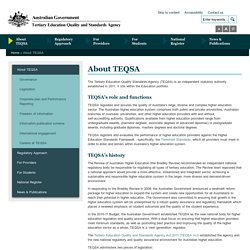
It sits within the Education portfolio. TEQSA's role and functions TEQSA regulates and assures the quality of Australia’s large, diverse and complex higher education sector. The Australian higher education system comprises both public and private universities, Australian branches of overseas universities, and other higher education providers with and without self-accrediting authority. Qualifications available from higher education providers range from undergraduate awards, (bachelor degrees, associate degrees or advanced diplomas) to postgraduate awards, including graduate diplomas, masters degrees and doctoral degrees. Department of Education and Training. All Australian governments have recommitted to the Closing the Gap targets under the National Indigenous Reform Agreement between the Australian Government and state and territory governments.
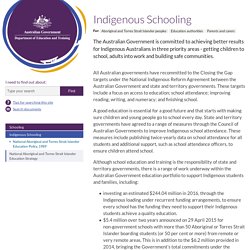
These targets include a focus on access to education; school attendance; improving reading, writing, and numeracy; and finishing school. A good education is essential for a good future and that starts with making sure children and young people go to school every day. State and territory governments have agreed to a range of measures through the Council of Australian Governments to improve Indigenous school attendance. These measures include publishing twice-yearly data on school attendance for all students and additional support, such as school attendance officers, to ensure children attend school. Strategy to improve Aboriginal education - NSW Department of Education. A new strategy to improve educational outcomes for Aboriginal children and young people will be delivered through 15 schools in some of NSW's most complex and disadvantaged communities.
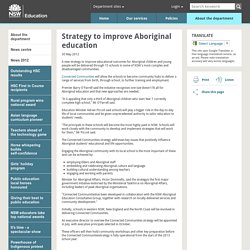
Connected Communities will allow the schools to become community hubs to deliver a range of services from birth, through school, to further training and employment. Premier Barry O'Farrell said the initiative recognises one size doesn't fit all for Aboriginal education and that new approaches are needed. "It is appalling that only a third of Aboriginal children who start Year 7 currently complete high school," Mr O'Farrell said.
Education Minister Adrian Piccoli said schools will play a bigger role in the day-to-day life of local communities and be given unprecedented authority to tailor education to students' needs. "The principals in these schools will become the most highly paid in NSW. Indigenous Education. Federal budget 2016: education experts react. The government is spruiking a focus on education to drive innovation in the 2016 budget but it has put off higher education reforms in favour of further consultation.
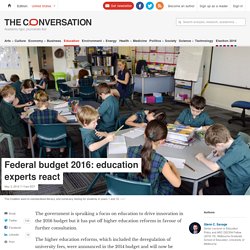
The higher education reforms, which included the deregulation of university fees, were announced in the 2014 budget and will now be delayed for another year. The total spend on education in this year’s budget is A$33.7 billion. Australian schools must promote LGBT-inclusive education. Earlier this month, it was revealed that Kevin Donnelly, one of the men tasked with reviewing Australia’s national curriculum, had argued in a 2004 book that “many parents” think the “sexual practices” of lesbian, gay, bisexual and transgender (LGBT) individuals are “decidedly unnatural”.
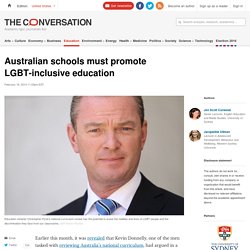
In 2005, Donnelly also wrote that it was: … wrong to introduce students to sensitive sexual matters about which most parents might be concerned and that the wider community might find unacceptable. Upon appointing Donnelly and Ken Wiltshire to review the national curriculum in January, education minister Christopher Pyne said that the review would ensure the curriculum is “balanced in its content, free of partisan bias and deals with real-world issues”. But in order to safeguard the learning and social experiences of all Australian students, LGBT content and insights should be critical parts of the curriculum. Australian education fails one in four young people – but not the wealthy ones. How do you know if an education system works well for all learners, not just those who are most likely to succeed?
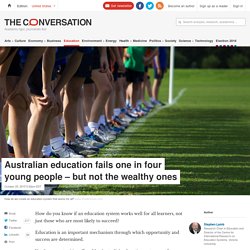
Education is an important mechanism through which opportunity and success are determined. Yet the opportunities offered by Australia’s education system are far from fairly and evenly distributed, according to new analysis from a report we’ve published today. Using publicly available data, such as the National Assessment Program – Literacy and Numeracy and the Australian Census, we look at educational progress from age five to 24 using four milestones as yardsticks for how well the system serves its students at each stage. These milestones are: being developmentally ready for school, succeeding at year seven, completing school by age 19, and being fully engaged in education, training or work at age 24.
At each milestone, around one in four Australian learners are not on track. Uneven access to quality early childhood care Second chances are important, but don’t work for all. Social class affects school achievement less than you think. In a recent article in The Conversation, Stewart Riddle cited UK, US and Australian research to argue that: … social class is the strongest predictor of educational achievement.
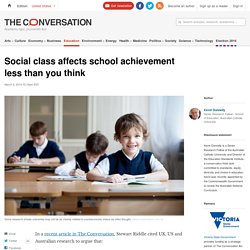
But recent research shows this isn’t the case. While there is no doubt that social class, whether measured by the parents' occupation, level of education, postcode or wealth, has a strong influence on students' educational outcomes, it is not the greatest influence. A counter argument to the belief that demography is destiny can be found in Gary Marks' recent publication, Education, Social Background and Cognitive Ability. Marks, a researcher at the Melbourne Institute of Applied Economic and Social Research at the University of Melbourne, has written extensively on the relationship between social class, educational outcomes and the reasons Catholic and independent schools achieve such strong results in areas like standardised tests, completion rates and tertiary entry.
Marks also observes that: The paper notes: Scrap school admissions policies based on postcode – they entrench inequality. Why are pupils from disadvantaged families more often found studying in poorly performing schools? Is it the choices their parents make, or are they not able to get into better ones? Perhaps families are choosing local schools despite low performance. Or perhaps the school admissions system, which is built around how close a child lives to a school, actually works against poorer families. Our new research shows that constraints such as proximity to a good school are driving more inequality between low and high-income families than other preferences around whether the school is strong academically.
We suggest new admissions systems – based around lotteries or “banding” based on ability – could help reduce some of this inequality. ACECQA - Ensuring quality early childhood education in Australia. Monday 20 June, 2016 The National Quality Framework (NQF) was the result of an agreement between all Australian governments to work together to provide better educational and developmental outcomes for children. The NQF introduced a new quality standard in 2012 to improve education and care across long day care, family day care, preschool/kindergarten, and outside school hours care. The NQF includes: Best Practice Teacher Education Programs and Australia s Own Prog. Statistics. The UNESCO Institute for Statistics is the first stop for education data from around the world. From primary school enrolments to tertiary graduation rates, the UIS education database is the most comprehensive in the world.
More than 200 countries and territories take part in the UIS annual education survey, which covers all education levels and a range of issues such as gender parity, teachers and financing. The UIS has the mandate to monitor progress towards Education for All and education-related Millennium Development Goals. The statistics, which are updated twice a year, are used by diverse partners, including governments, donor agencies and other UN organizations. In particular, the UIS is the primary education data source for the Education for All Global Monitoring Report, the World Development Indicators and the Human Development Report, among others. Quick links: What Works - The Work Program - Improving Outcomes for Indigenous students. 4704.0 - The Health and Welfare of Australia's Aboriginal and Torres Strait Islander Peoples, Oct 2010. 05/04/2013 Note: 2002 and 2008 NATSISS alcohol data by risk level have been revised. For more information, see the Information Paper (Catalogue No. 4714.0.55.005).
Education can influence health through a range of complex mechanisms like income and access to health care, and participation in the labour market (employment) (Endnote 1). Educational attainment can be associated with developing information and cognitive skills, choices, and participation in social networks (Endnote 1). Education has also been found to be strongly linked to determinants of health such as risky health behaviours and preventative service use (Endnote 2).
Despite a growing body of research that suggests a correlation between education and health, the relationship is far from straightforward – there is no consensus on, and quite limited research into establishing a causal link between the two. Results from the 2008 NATSISS show that higher levels of schooling were positively associated with health status. 1. 2. Ctgc rs12.